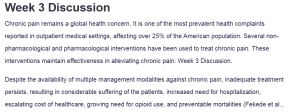Week 3 Discussion
Chronic pain remains a global health concern. It is one of the most prevalent health complaints reported in outpatient medical settings, affecting over 25% of the American population. Several non-pharmacological and pharmacological interventions have been used to treat chronic pain. These interventions maintain effectiveness in alleviating chronic pain: Week 3 Discussion.
Despite the availability of multiple management modalities against chronic pain, inadequate treatment persists, resulting in considerable suffering of the patients, increased need for hospitalization, escalating cost of healthcare, growing need for opioid use, and preventable mortalities (Fekede et al., 2023). Insufficient management of chronic pain across the lifespan has been attributed to apparent disparities in healthcare access, poor understanding of the etiological factors underlying chronic pain and the respective management strategies, inconsistencies in pain management approaches, and biases in pain evaluation (Tata et al., 2024). It is thus necessary that nurse practitioners comprehensively understand pain management.
The purpose of this research is to explore the impact of insufficient chronic pain management on the quality of life and mental wellness of adults within the community setting. The study will integrate a qualitative design to elucidate the perceived effects of chronic pain on physical and mental wellness.
The research question that will be used in the study is: How does insufficient management of chronic pain impact the physical and mental wellness of adults with chronic pain?
PICOT Format
- Patient Population or Problem: The target population is hospitalized adults. These populations are considerably affected by chronic pain and are accustomed to other primary illnesses.
- Intervention: Assess the impact of poor management of chronic pain.
- Comparison: Effective pain management, integrating best practices in pain handling and management.
- Outcome: Morbidity, need for hospitalization, and increased pill burden.
The revised PICO(T) question is: In adult populations (P), does poor management of chronic pain (I), compared with best practices in pain handling (C), result in significant morbidity (O), need for hospitalization, and increased pill burden?
References
Fekede, L., Temesgen, W. A., Gedamu, H., Kindie, S., Bekele, T. G., Abebaw, A., Baymot, A., & Difer, M. (2023). Nurses’ pain management practices for admitted patients at the comprehensive specialized hospitals and its associated factors, a multi-center study. BMC Nursing, 22(1). https://doi.org/10.1186/s12912-023-01528-x
Tata, T. K., Ohene, L. A., Dzansi, G. A., & Aziato, L. (2024). Factors influencing nurses’ pain assessment and management of road traffic casualties: A qualitative study at a military hospital in Ghana. BMC Emergency Medicine, 24(1). https://doi.org/10.1186/s12873-024-01016-8
ORDER A PLAGIARISM-FREE PAPER HERE
We’ll write everything from scratch
Question 
Discussion Question
Formulating the Research Question, Problem Statement, Research Purpose
In the Week1discussion forum you had an opportunity to present a potential problem and an innovative solution specific to your role specialization.In addition, you have reviewed the literature to identify qualitative and quantitative research articles and submitted annotated bibliographies to provide evidence supporting the problem.
Considering the feedback provided to you by the faculty member it is now time to prepare your problem statement, research purpose, and research question.
First share your refined problem and proposed solution (given your review of literature this may have changed depending on the evidence you were able to provide). Next, follow the steps to help define your research question.
1. Craft the problem statement and research purpose.
2. Design your research question aimed at solving (a part of) the problem and include the following
components which will focus the literature review.

Week 3 Discussion
PICOT Question:
Patient, Population or Problem
1. What are the characteristics of the patient or population?
2. What is the condition or disease you are interested in?
Intervention or exposure
3. What do you want to do with this patient (e.g. treat, diagnose, observe)?
Comparison
4. What is the alternative to the intervention (e.g. placebo, different drug, surgery)?
Outcome
5. What are the relevant outcomes (e.g. morbidity, death, complications)?
6. Ensure that the research question is answerable, feasible and clinically relevant
The next step in Submissions Area will be to develop a research hypothesis from the research question.
Provide constructive feedback to your classmate‘s responses.